Never do this 5 things in Japan if you don’t want to get kick out
Common sense changes when the place changes. There are cases in which rules that must be followed in your country may not be necessary in Japan, but there are also cases where the opposite exists. Japan is known as a manner country with many unique manners and rules that everyone is supposed to follow. Since it can become a big problem sometimes if you don't follow these rules, it is recommended to check the etiquette and rules you need to know before taking a trip to Japan.
Talk or Make Phone Calls Loudly on the Train
Many people take out their smartphones to kill some time when they feel bored on the train or other public transportation, such as playing games, watching videos or chatting with friends. Talking on the phone on the train seems to be commonplace overseas, but it's considered bad manners in Japan. Japanese people often only use e-mail and chatting apps on trains. There is no problem exchanging messages, but if you make a phone call on the train, most people will think that you are rude. If you must talk on the phone, remember to lower your voice and it is better to do it after getting off the train.
When talking to people on the train, also should be careful of the volume of your voice. This rule depends on the region in Japan, and it is especially important on crowded trains. In the case of Tokyo, the more people there are on the train, the fewer people talk loudly. It is also important to turn off mobile phones near priority seats.

Japan Train Sation
Enter the Train Tracks
In Japan, it is forbidden to enter train tracks. This is the same even when the train is not running, and entering the premises is prohibited by law. Taking pictures on the railroad tracks might give you a nice view of the scenery, but you should never take pictures on train tracks in Japan. It is also prohibited to place stones or objects on the tracks. Please be careful if you are traveling with children because behaviors that sabotage the trains such as laying stones are very serious sins.
In Japan, trains in Kamakura are very popular with foreigners, especially fans of Japanese manga(anime) "Slam Dunk" since Kamakura is the main stage of the story. Many foreigners stay on the tracks until the train comes, or hold the camera so close that they almost hit the train. This problem is considered very serious and there are even security guards standing at railroad crossings.
Such behaviors may lead to train delays and may cause inconvenience to many people, and the railway company may demand a large amount of compensation for damages.
Smoke in a Non-Designated Area
In Japan, it is polite to smoke only in designated areas to avoid secondhand smoke and to respect nonsmokers. However, many foreign tourists are confused about where to smoke. In Japan, smoking is illegal in public indoor spaces (restaurants, cafes, bars, etc.), partially enclosed spaces (buildings with open roofs or walls, bus stops, etc.), and in the workplace.
Although you can smoke indoors in some designated areas, you can't smoke while walking the streets of Tokyo. There are places where you will be fined if you smoke while walking. You can also be fined for throwing cigarettes or garbage on the street.

Street of Tokyo
Take Photos Without Consent
Before taking a photo, be sure to check the places where you are not allowed to take pictures in Japan. If you want to know if you can take pictures, ask the people around you. Photography is often prohibited in museums and galleries in Japan. This rule is made to protect copyright, and Japan is a very strict country against "copyright". Also, please note that some shopping malls and cafes may not allow you to take pictures of other people. In addition, it is prohibited to photograph books and magazines in bookstores, libraries, cinemas, etc. In Japan, this is called "digital shoplifting".
It is also prohibited to take pictures in hot springs. If you want to take pictures, remember to ask someone else for permission first. Even if you are allowed to take pictures, do not take pictures of other bathers, or make them uncomfortable. Also, do not post such photos online.
Enter Someone's House With Shoes On
In Japan, one way to clearly distinguish between the inside and outside of a building is the practice of not wearing shoes indoors. The act of "taking off one's shoes" means being the owner of the building or submitting oneself to the rules that apply within the building. In other words, it shows a lack of animosity, respect, and trust in the other person.
Of course, there are also hygiene reasons. Therefore, most Japanese still don't wear shoes inside their homes. Instead, they may wear indoor shoes such as slippers, but they are clearly distinguished from shoes for outside. Even if you may not have so many opportunities to visit Japanese houses, be careful with the rules regarding shoes when entering Japanese-style spaces such as shrines and temples, inns, and restaurants.

Japanese-style Teahouse

 Share
Share